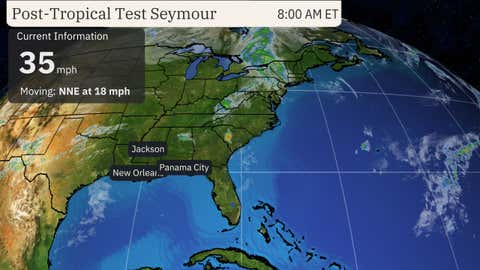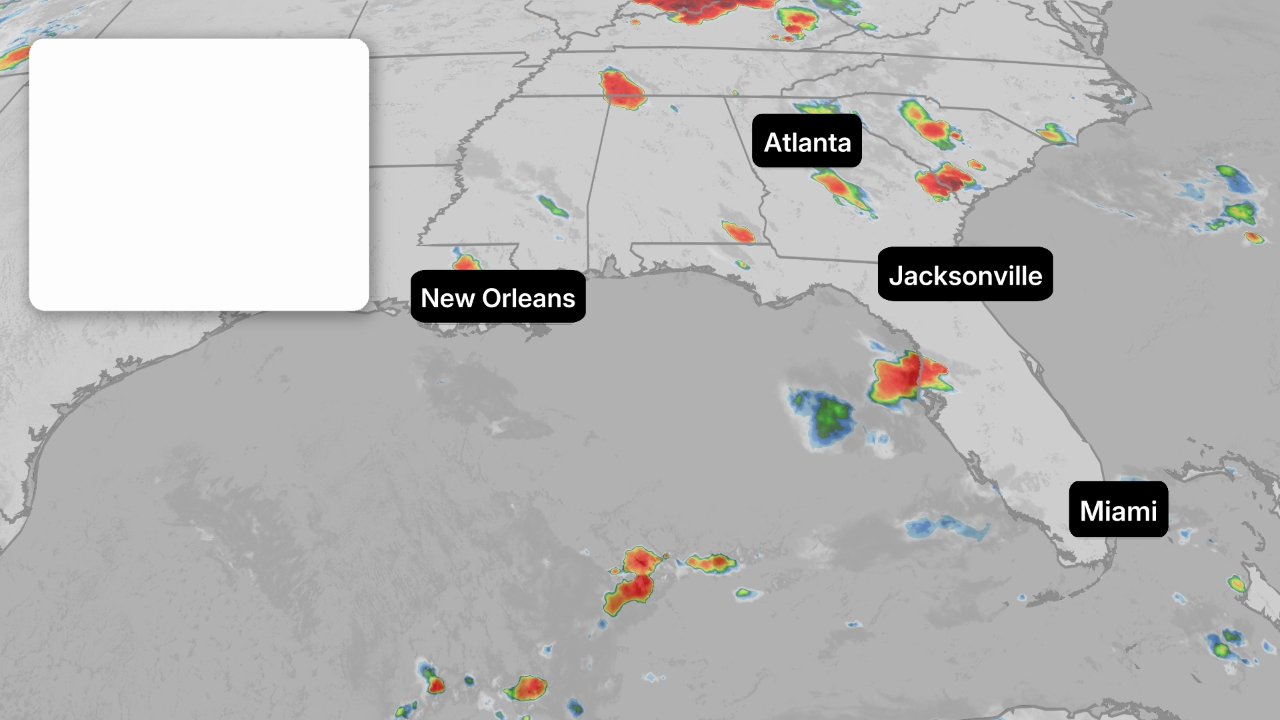
- Tropical Storm Bret is arriving in the Caribbean.
- Tropical Depression Four has formed in the Central Atlantic.
- This is very unusual for June, as most June storms develop in the Gulf of Mexico or off the East Coast.
Tropical Storm Bret is spreading into the Lesser Antilles and Tropical Depression Four is located farther east in the Central Atlantic.
Latest On Bret
Here's where Bret is right now: Bret's center is now pushing into the eastern Caribbean.
Winds have gusted as high as 52 mph at Grantley Adams International Airport on the southern end of Barbados east of the island's capital, Bridgetown.
Bret's worst weather will likely come after its center passes through the islands as wind shear is sweeping much of its thunderstorm activity to the east of its center.
The National Hurricane Center began issuing forecast advisories on this system late Monday morning, as it had enough low-level spin and thunderstorms near it to be designated a tropical cyclone.
Bret will continue on its current path: Bret's intensity leveled off Thursday after nearing hurricane strength Wednesday night.
Bret will continue on its westerly track over the next few days.
It is expected to weaken in the eastern Caribbean Sea where it will encounter increasingly hostile winds. The National Hurricane Center forecast calls for Bret to dissipate sometime this weekend.

Current Status And Forecast Path
(The red-shaded area denotes the potential path of the center of the tropical cyclone. It's important to note that impacts (particularly heavy rain, high surf, coastal flooding, winds) with any tropical cyclone usually spread beyond its forecast path.)Bret is a threat to the Lesser Antilles. On its path, Bret will sweep through parts of the Lesser Antilles into early Friday.
The storm will bring strong wind gusts, heavy rain and dangerous waves to the Lesser Antilles.
Rainfall totals of 3 to 6 inches, with up to 10 inches possible are expected across portions of the Lesser Antilles from Guadeloupe south to St. Vincent and the Grenadines, including Barbados, according to the National Hurricane Center. The heavy rainfall could lead to flash flooding, especially across areas of higher terrain.

A hurricane watch remains in effect for St. Lucia, where hurricane conditions are possible in the next 24 hours if Bret briefly becomes a hurricane.
Otherwise, tropical storm warnings are in effect for Dominica, St. Lucia, Martinique, Barbados, and St. Vincent and the Grenadines.
Warnings are issued when the specified condition - tropical storm or hurricane - is expected within the warning area within 36 hours. Watches are typically issued when those conditions are possible within the watch area in the next 48 hours.

Watches, Warnings
(A watch is issued when tropical storm or hurricane conditions are possible within 48 hours. A warning is issued when those conditions are expected within 36 hours.)Bret won't threaten the mainland United States given the forecast calls for its dissipation in the Caribbean.
Tropical Depression Four
Tropical Depression Four is moving west-northwestward after forming early Thursday. This system is expected to strengthen to a tropical storm in the next day or so. It will be named Cindy when it becomes a tropical storm.
For now, it's no immediate threat to land and is expected to turn toward the northwest over the next few days. If it remains on that northwest path, it would track north of the Leeward Islands early next week. But interests in the Leeward Islands should continue to monitor this forecast over the next several days.

Current Status And Forecast Path
(The red-shaded area denotes the potential path of the center of the tropical cyclone. It's important to note that impacts (particularly heavy rain, high surf, coastal flooding, winds) with any tropical cyclone usually spread beyond its forecast path.)Record ocean warmth is providing fuel. One factor that has contributed to the development of Bret and Tropical Depression Four is ocean warmth. All other factors equal, warmer ocean water can provide more fuel for tropical systems to intensify.
Over the strip of the Atlantic Ocean between Africa and the Lesser Antilles is an area known as the "main development region" (MDR), where many intense hurricanes get their start. Ocean temperatures there have smashed mid-June records. Water temperatures near Cabo Verde and points west into the central tropical Atlantic are generally in the low 80s, which is sufficient heating for tropical development.
WPLG-TV hurricane expert Michael Lowry noted these sea-surface temperatures are more typical of the heart of hurricane season - early September - rather than June. Water temperatures in the proximity of this system are 2 to 5 degrees above average.
That's due in part to lighter than usual trade winds from a weaker than average Bermuda-Azores high, according to Brian McNoldy, tropical scientist at the University of Miami.
This is a weird place for storms to develop in June. Only about 6% of all storms form in June.
Of the June storms that do form, the overwhelming majority form in the Gulf of Mexico or just off the East Coast.
Only three of 79 June storms since the 19th century have formed east of the Lesser Antilles, according to NOAA's database.
Furthermore, there is no record of two storms active at once in June east of the Antilles. So, if we have both Tropical Storm Bret and Tropical Storm Cindy, that would be unprecedented for that part of the Atlantic Basin in June.
Two of those formed in the past six years. What would later become Hurricane Elsa first became a tropical storm just hours before June ended in 2021. Tropical Storm Bret in 2017 was a short-lived storm that eventually fizzled after soaking Trinidad and Tobago. Tropical Storm Ana in 1979 was the only other such June MDR storm in NOAA's database.

Tracks of all tropical storms, subtropical storms and hurricanes in June from 1842 through 2022. Few have formed during June in the main development region between the Lesser Antilles and Africa.
(NOAA/NHC)Jonathan Erdman is a senior meteorologist at weather.com and has been an incurable weather geek since a tornado narrowly missed his childhood home in Wisconsin at age 7. Follow him on Twitter and Facebook.
The Weather Company’s primary journalistic mission is to report on breaking weather news, the environment and the importance of science to our lives. This story does not necessarily represent the position of our parent company, IBM.
World - Latest - Google News
June 23, 2023 at 01:11AM
https://ift.tt/uC9s5ag
Tropical Storm Bret Pushes Through The Lesser Antilles | Weather.com - The Weather Channel
World - Latest - Google News
https://ift.tt/cWkFstf
https://ift.tt/5Y10Ioe
Bagikan Berita Ini















0 Response to "Tropical Storm Bret Pushes Through The Lesser Antilles | Weather.com - The Weather Channel"
Post a Comment